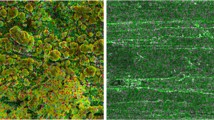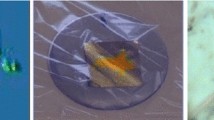Abstract
A Peltier-cooled silicon drift detector was successfully applied for conversion electron spectrometry. The energy resolution of the detector for 45 keV electrons was 0.50 keV (FWHM). The approximate thickness of the dead layer was determined to be 140 ± 20 nm Si equivalent. The relative efficiency of the detector was verified to be approximately constant in the energy range of 17–75 keV. This is concordant with the high transparency of the thin dead layer and the sufficient thickness of the detector (450 μm) to stop the electrons. The detector is suitable for use in plutonium analysis of chemically prepared samples. Moreover, it was demonstrated that conversion electron spectrometry is better than alpha spectrometry in preserving its capability to determine the 240Pu/239Pu isotopic ratio as a function of sample thickness. The investigated measurement technique can be considered a promising new tool in safeguards, complementary to existing methods.





Similar content being viewed by others
References
León Vintró L, Mitchell PI, Condren OM, Moran M, Vives i Batlle J, Sánchez-Cabeza JA (1996) Determination of the 240Pu/239Pu atom ratio in low activity environmental samples by alpha spectrometry and spectral deconvolution. Nucl Instrum Methods Phys Res A 369:597–602
Pöllänen R, Siiskonen T, Ihantola S, Toivonen H, Pelikan A, Inn K, La Rosa J, Bene BJ (2012) Determination of 239Pu/240Pu isotopic ratio by high-resolution alpha-particle spectrometry using the ADAM program. Appl Radiat Isot 70:733–739
Ihantola S, Pelikan A, Pöllänen R, Toivonen H (2011) Advanced alpha spectrum analysis based on the fitting and covariance analysis of dependent variables. Nucl Instrum Methods Phys Res A 656:55–60
Shiokawa Y, Suzuki K, Suzuki S, Yagi M (1990) Determination of isotopic ratios of plutonium and curium by internal conversion electron spectrometry. J Radioanal Nucl Chem 143(1):135–141
Trzaska WH (1990) Recommended data on selected gamma-ray and conversion-electron calibration sources. Nucl Instrum Methods Phys Res A 297:223–229
Deslattes RD, Kessler EG Jr, Indelicato P, de Billy L, Lindroth E, Anton J, Coursey JS, Schwab DJ, Chang J, Sukumar R, Olsen K, Dragoset RA (2005) NIST Standard Reference Database 128, X-Ray Transition Energies, http://www.nist.gov/pml/data/xraytrans/index.cfm. Accessed May 2013
Evaluated Nuclear Structure Data File (ENSDF) (2013) http://www.nndc.bnl.gov/ensdf/. Accessed May 2013
Ziegler JF, Biersack JP, Ziegler MD (2008) The stopping and range of ions in matter. http://www.srim.org. Accessed May 2008
Kawrakow I, Mainegra-Hing E, Rogers DWO, Tessier F, Walters BRB (2011) The EGSnrc Code System, NRC, Canada. NRCC Report PIRS-701
DeVol TA, Ringberg AH, Dewberry RA (2002) Isotopic analysis of plutonium using a combination of alpha and internal conversion electron spectrometry. J Radioanal Nucl Chem 254(1):71–79
Kibédi T, Burrows TW, Trzhaskovskaya MB, Davidson PM, Nestor CW Jr (2008) Evaluation of theoretical conversion coefficients using BrIcc. Nucl Instrum Methods Phys Res A 589:202–229
Acknowledgments
The authors would like to thank the University of Jyväskylä, Finland for lending the required 133Ba source, VTT Technical Research Centre of Finland for providing the Pu particle sample and the reference material and Kaisa Vaaramaa (STUK) for producing the thin Pu sample.
Author information
Authors and Affiliations
Corresponding author
Rights and permissions
About this article
Cite this article
Peräjärvi, K., Turunen, J., Ihantola, S. et al. Feasibility of conversion electron spectrometry using a Peltier-cooled silicon drift detector. J Radioanal Nucl Chem 299, 229–234 (2014). https://doi.org/10.1007/s10967-013-2788-0
Received:
Published:
Issue Date:
DOI: https://doi.org/10.1007/s10967-013-2788-0




